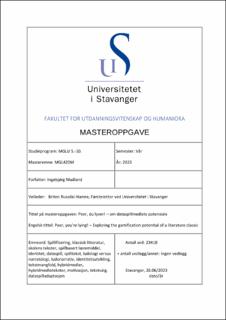| dc.contributor.advisor | Russdal-Hamre, Briten | |
| dc.contributor.author | Madland, Ingebjørg | |
| dc.date.accessioned | 2023-08-21T15:51:13Z | |
| dc.date.available | 2023-08-21T15:51:13Z | |
| dc.date.issued | 2023 | |
| dc.identifier | no.uis:inspera:148120589:148120914 | |
| dc.identifier.uri | https://hdl.handle.net/11250/3085115 | |
| dc.description.abstract | Formålet med denne oppgaven er å undersøke hvordan Aschehougs dataspilladaptasjon av Peer Gynt kan stimulere til identitetsutvikling hos ungdomsskoleelever. Studiens tekstanalytiske tilnærming til det spillbaserte læremiddelet preges av et tverrfaglig teoretisk bakteppe, sydd sammen av perspektiver fra ludologi (spillvitenskap), narratologi (litteraturteori og filmvitenskap) og psykologi. Oppgaven tematiserer de aktuelle debattene ludologi versus narratologi, det utvidete tekstbegrepet (i norskfaglig kontekst), samt debatten rundt hvilke tekster som bør være skolens tekster.
I lys av Espen Aarseths ludonarrative analysemodell viser klassifiseringen av Peer Gynt at spillteksten er tydelig narrativ. Dette sår tvil om «dataspillet» er et dataspill. Spillteksten innfrir ikke kravene for å være et dataspill, som stilles i Jesper Juuls klassiske spillmodell, men kan forstås som et spillbasert læremiddel. Dette baseres på tilstedeværelsen av de spillspesifikke trekkene relatert til QTE-bruk, tilbakemeldingsfunksjon, valgsituasjoner og «lore». Gjennomføringen av spillifiseringen er likevel mangelfull. Dette redegjøres for ved bruk av spillifiseringsheuristikker for ivaretakelse av identitetsutvikling gjennom motiverende utforming, men også ved å sammenligne med hvordan tilsvarende trekk realiseres i de mest høyfrekvente spillene blant den aldersrelevante gruppen. Resultatet er at autonomi, kompetanse og tilhørighet ikke ivaretas i utformingen. Dette antyder at en tekstlig tilnærming vil være mer gunstig i møte med spillet enn en spillspesifikk tilnærming. En sammenligning mellom de fortellingsformidlende tilpasningene i scenen «Bukkerittet», mellom Aschehougs Peer Gynt og Moen og Mairowitz’ tegneserieadaptasjon, tematiserer autentisitet og performativ identitet knyttet opp mot moderne, vestlig «flytende» identitet. En slik identitetsfremstilling aktualiseres ikke i like betydelig grad gjennom grepene som er gjort i Aschehoug Peer Gynt.
Resultatene av denne studien understreker lærerens verdifulle rolle i litteraturundervisning og tekstbruk i skolen, samt viktigheten av at man som lærer stiller seg kritisk, også til læreverkpubliserte tekster, i sin utvelgelse av undervisningstekster og utforming av didaktiske rammer for tiltenkte læringsmål. | |
| dc.description.abstract | The aim of this study is to examine how Aschehoug's video game adaptation of Peer Gynt can facilitate identity development among middle school students. The study employs a text-analytical approach to the game-based learning resource, drawing on a multidisciplinary theoretical framework that incorporates perspectives from ludology (the study of games), narratology (literary theory and film studies), and psychology. The research explores the current debates surrounding ludology versus narratology, the expanded notion of text within the field of Norwegian language arts, and the ongoing discourse on the selection of texts for educational purposes.
Applying Espen Aarseth's ludonarrative model, the classification of Peer Gynt demonstrates a pronounced narrative structure within the game. This raises doubts as to whether the "video game" can be unequivocally categorized as such. The game falls short of meeting the criteria stipulated by Jesper Juul's classic game model, thus positioning it as a game-based learning resource rather than a conventional video game. This categorization is supported by the presence of game-specific elements such as Quick Time Events (QTEs), feedback mechanisms, choice-based situations, and lore. Nevertheless, the implementation of gamification remains incomplete. This deficiency is explicated through the application of gamification heuristics aimed at studying identity development through motivational design. Furthermore, a comparative analysis with prevalent games among the target age group highlights disparities in addressing autonomy, competence, and belonging. Consequently, a textual approach appears more advantageous when engaging with the game, as opposed to a game-specific approach.
An examination of the narrative adaptations in the “Bukkerittet” scene, as depicted in Aschehoug's Peer Gynt and Moen and Mairowitz's comic book adaptation, sheds light on authenticity and performative identity in relation to contemporary Western notions of “liquid” identity. The degree to which these representations of identity are emphasized in Aschehoug's Peer Gynt falls short in comparison.
The findings of this study underscore the pivotal role of teachers in literature education and text utilization within educational settings. Additionally, they emphasize the importance of critical evaluation, including published instructional texts, in the selection of teaching materials and the design of didactic frameworks aimed at achieving intended learning objectives. | |
| dc.language | nob | |
| dc.publisher | uis | |
| dc.title | Peer, du lyver! - om dataspillmediets potensiale | |
| dc.type | Master thesis | |
